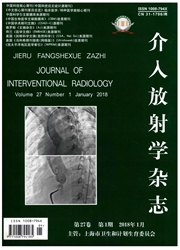

 中文摘要:
中文摘要:
目的探讨新型暂时性贲门支架治疗实验性犬贲门失弛缓症的疗效和安全性,研究支架取出后不同随访时间点的贲门段食管组织病理学变化特征。方法采用苄基二甲基十四烷氯化铵(BAC)内镜下食管下括约肌(LES)内环周注射法,24条毕格犬成功建立实验性贲门失弛缓症模型,随机分为对照组和实验组,每组12条,分别植入普通食管支架和新型贲门支架;支架留置4d后取出。于造模前、造模后和支架取出后1周,1、3和6个月,对各实验犬作食管测压和计时食管钡剂造影(TBE)检查,并于支架取出后每一随访时间点各处死3条实验犬,取贲门段食管作病理学检查。结果支架植入、取出和随访检查均顺利实施。两组均未发生食管穿孔等严重并发症。组间比较显示实验组支架移位率较低(实验组1条,对照组5条);实验组LES静息压降低更显著(支架取出后6个月时,组间差异有统计学意义,P=0.027);实验组TBE0~5min乘积差更大(支架取出后3个月时,组间差异有统计学意义,P=0.009)。LES静息压组内多重比较显示实验组有效维持期更长。增殖细胞核抗原(PCNA)和α-平滑肌肌动蛋白(α-SMA)免疫组化标记染色均显示食管贲门段组织炎症反应在随访1个月时达峰值;Masson三色法染色显示胶原纤维增生指数于随访3个月时趋于稳定状态。结论本实验中,新型暂时性贲门支架治疗犬贲门失弛缓症在安全性和疗效方面均优于普通食管支架。
 英文摘要:
英文摘要:
Objective To assess the efficacy and safety of a newly-designed temporary covered cardia stent for the treatment of achalasia in canine models and to investigate the histopathological changes at different points of follow-up time after the stent was removed. Methods The canine achalasia model was created by injecting benzyl-dimethyl-tetradecyl ammonium chloride (BAC) circumferentially into the lower esophageal sphincter (LES) of the dogs. Twenty-four dogs with achalasia were randomly and equally divided into two groups with 12 dogs in each group:control group (using routine esophageal stents) and study group (using newly-designed temporary covered cardia stents). Under fluoroscopic guidance stents were implanted in the esophagus and were taken away from the esophagus 4 days after stent insertion in experimental dogs of both groups. LES pressures and timed barium esophagography (TBE) were performed in all dogs before and immediately after the stenting procedure,as well as at one week,3 and 6 months after the stent was removed. Every three dogs were sacrificed each time at one week,3 and 6 months after the stent was removed. The esophageal cardia was excised and sent for pathological examination. Results All animals well tolerated the stent insertion / removal and the follow-up procedures. No severe complications such as esophageal perforation occurred. Comparison between two groups showed that stent migration occurrence was much lower in study group (n = 1) than that in control group (n = 5). The reduction of LES pressures in study group was more significant in comparison with control group (at 6-month follow-up,P = 0.027). The difference in barium column product (height × width) between 0-min and 5-min TBE was statistically significant in study group (at 3-month follow-up,P = 0.009). Integrated analysis of multi-comparison for LES pressures among subgroups of each group revealed that the dogs in study group exhibited better outcomes than the dogs in control group. Both p
 同期刊论文项目
同期刊论文项目
 同项目期刊论文
同项目期刊论文
 Comparison of tissue reaction with three different endografts used for exclusion of carotid artery a
Comparison of tissue reaction with three different endografts used for exclusion of carotid artery a Management of acute malignant colorectal obstruction with a novel self-expanding metallic stent as a
Management of acute malignant colorectal obstruction with a novel self-expanding metallic stent as a Comparison of temporary stent insertion with pneumatic dilation of the same diameter in the treatmen
Comparison of temporary stent insertion with pneumatic dilation of the same diameter in the treatmen 期刊信息
期刊信息
